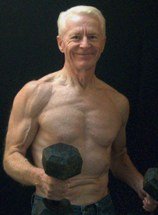Hi

October 15, 2020
In this newsletter . . .
What Keeps
You Young?
Recently a middle-aged Wall Street Journal staffer did something very much out of the ordinary. Anne Marie Chaker, age 45, two years after picking up her first barbell, competed in a women’s bodybuilding contest. There she stood, onstage in a hotel ballroom, in four-inch heels and wearing a rhinestone bikini, which she described as, “small enough to fit into a zip-lock bag.”Some six years after a series of personal misfortunes, the mother of two got into bodybuilding after a chance meeting with a woman bodybuilder at a hotel gym. And Ms. Chaker herself decided to give it a try. As the weeks went by, she loved seeing what was happening to her body. Bodybuilding was transforming her, giving her confidence, and teaching her to value strength over skinniness.
Getting ready for the competition, she began performing nearly two-hour daily weight-based workouts with exercises she had long associated with football players. Squats, dead lifts, bench presses.
She
wrote about her odyssey in the Wall Street Journal, and the reader responses poured in. Example: Gilles Georges from Mason, Ohio, wrote:
“I am myself on a new workout routine; I know the sacrifices of counting calories, watching your three macronutrients, taking progress pictures, and challenging yourself every day. Not Easy.
“I am 53 years old and my goal is to regain the muscle mass that I lost over time by focusing too much on my career. I don’t want to be that guy getting old, seeing his body decline and say, ‘If only I had done something.’ After 12 weeks of intense efforts I see the first subtle benefits of my hard work. It keeps me going.”
So, are barbells truly the fountain of youth? To a large degree, yes, they are. And when I say “barbells” I am of course including dumbbells, kettlebells and resistance bands. Resistance work by any means.
We are all going to age, get old. We know that. But training with weights can forestall many of aging’s gradual debilitations. In fact, resistance work allows us to retain, or even reclaim, many assets of youth.
Inactive men and women over age 30 slowly lose muscle tissue every year. At about age 50 this loss of muscle (and strength and endurance) starts happening faster. And after age 65, it accelerates even more. Scientists have a name for it. They call it “sarcopenia.” It is from the Greek, meaning “poverty of flesh.” It is what we see in frail, elderly people who are bent over from a combination of osteoporosis and sarcopenia, the wasting away of
muscle tissue.
The miracle of weight training is that it slows muscle tissue loss associated with aging. In fact, it is even possible to regain muscle that has been lost. Cardiovascular training and stretching have their place in a balanced fitness plan. But it is progressive resistance exercise that builds muscle, allowing us to stay young, active and independent for as long as possible. Nothing else comes close to being as effective.
And three cheers for Anne Marie Chaker!
Stay Healthy. Stay fit.
Logan
Senior Exercise Central
Are you on Facebook?
Check out the Senior Exercise Central page at . . .
https://www.facebook.com/GrayIronFitness
I search the Internet for senior health and fitness items. If you like what you see, please click the Like button. It helps me.
Spread the word. If you like the newsletter, we're making it easy to share it



Newsletter Policy
The Gray Iron Fitness Newsletter is a free publication sent twice monthly to subscribers. The purpose is to provide honest and realistic fitness information for people age 50 and above.
I have never been paid or received compensation of any kind to write a positive review or endorse a product. If I say that I personally use a product or service, it is because I find value in it and have paid for it with my own money.
Like newspapers, magazines and television, this newsletter and my web site contain advertising and marketing links. Naturally, I am compensated for these.
The newsletter and web site provide information to help users establish and maintain a fitness lifestyle. But fitness information is not the same as fitness advice, which is the application of exercise and dietary practices to an individual's specific circumstances. Therefore, always consult with your physician for assurance that fitness information, and
your interpretation of it, is appropriate for you.Your comments and questions are always appreciated. Simply click on the "Reply" bottom.
Sincerely,
Logan Franklin
The Gray Iron Fitness Newsletter
www.senior-exercise-central.com

